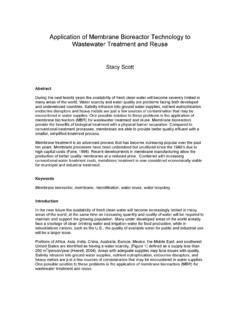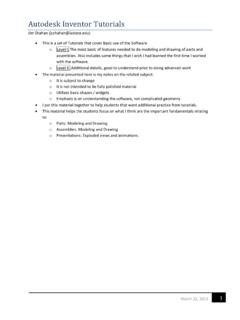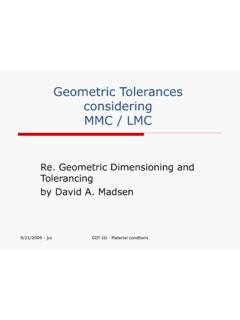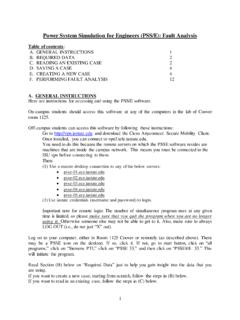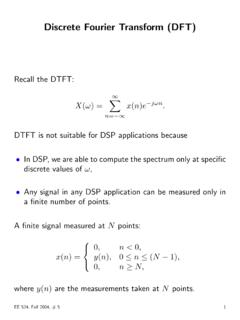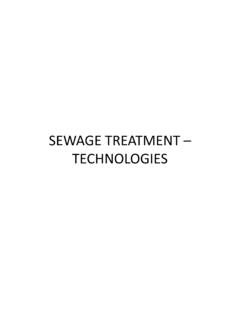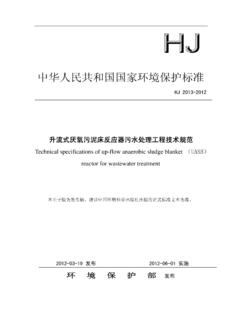Transcription of Comparisons Between the UASB and the EGSB Reactor Seung …
1 1 Comparisons Between the UASB and the EGSB Reactor Seung J. Lim ABSTRACT Some characteristics of Upflow Anaerobic Sludge Blanket (UASB), Expended Granule Sludge Blanket (EGSB), and Static Granular Bed Reactor (SGBR) were investigated in order to compare performances of the three and recognize advantages and disadvantages, respectively. The UASB Reactor is developed in the late 1970s and became rapidly widespread due to great performances. With granules, this Reactor is able to treat various high-strength industrial wastewaters and most soluble wastewater could be applied in this Reactor . The EGSB Reactor was also developed to give more chances to contact Between wastewater and granules. Besides, this Reactor is able to separate dispersed sludge from mature granule using rapid upward velocity.
2 Then, it is possible to treat high-strength and low-strength wastewater such as domestic wastewater, especially low temperature. The SGBR is innovated at IOWA state University and good performances have been reported for various wastewaters similar to the UASB and the EGSB Reactor . This Reactor is downflow unlike other reactors. And, it is very simple so that additional parts are not needed for this process. Sludge granulation process is not clearly understood yet, but EPS is very important a role to make a granule. Moreover, its structure and granulation process have been researched continuously. KEYWORDS anaerobic digestion, granule, UASB, EGSB, SGBR INTRODUCTION Anaerobic treatment was the history of wastewater treatment itself.
3 Anaerobic treatment has been used for the treatment of concentrated industrial wastewater as well as domestic wastewater (McCarty and Smith, 1986). Jewell (1987) told that the septic tank was the simplest, the oldest, and the most widely used process. Anaerobic treatment has a lot of advantages such as low energy consumption, low production of waste biological solids, storage ability unfed for many months, low nutrients and chemicals requirements, great removal at even high loading rate, pathogen removal, improving dewaterbility and producing energy gases. In comparison, it has some disadvantages like sensitive and vulnerable process, odor problem, long period needed for start-up the process and necessity of post treatment for discharge standards.
4 However, lots of knowledge about xenobiotic compounds and toxic compounds has been researched gradually. And, as a matter of fact, anaerobic digestion process is very stable process if the system operated is understood well. When a starting-up full scale anaerobic treatment process, the sufficient inoculation is provided due to overcome its drawback. In case of odor problem, it can be prevented using physicochemical or biological process (Lettinga, 1996). Lettinga (1996) told that anaerobic treatment process makes mineral compounds such as ammonium, phosphate, or sulfide and needs additional post treatment for a sustainable environmental protection can be met. The anaerobic treatment has been rapidly developed since the late 1960s.
5 The anaerobic sludge bed reactors have three concepts as follows (Lettinga, 1996). First, the immobilized balanced micro-ecosystem is formed. Second, the immobilized anaerobic aggregates have high settleability. Third, mass transport is prevalent Between granule and bulk solution. Since Young and McCarty (1969) developed the anaerobic filter, there have been a lot of research on the high rate anaerobic treatment. In Europe, however, the Reactor which could be obtained greater performance was developed, UASB Reactor in Netherlands in the late 1970s. 2 The aim of this article is to compare Between the UASB and the EGSB Reactor , and present not only application but also research trends each Reactor . Besides, this article handles with sludge granulation before reactors contents and gives the information of SGBR which is one of modified processes.
6 SLUDGE GRANULATION Introduction. Sludge granulation is a so complex and affected by many factors. Besides, this process is not clearly understood yet. Although there have been so many results of research on the granulation of sludge, they have already lots of hypotheses to make theories and understand observations (Wu et al., 1991; Thaveesri et al., 1994; Fang et al., 1994; Schmidt and Ahring, 1996). Most microorganisms of granules are denitrifying, nitrifying, acidogenic, and methanogenic bacteria. However, several factors determine characteristics of granules. For instance, there are characteristics of organisms, growth rate of organisms, and death rate and decay rate of the organisms in granules (Lettinga, 1996).
7 Nicolella et al. (2000) proposed the concentration-flow rate plane to design criteria applicable to different Reactor . Figure 1. Concentration-flow diagram for sludge granulation (Nicolella et al., 2000). Inorganic composition. The inorganic composition of sludge granule changes according to wastewater, process condition, and so on. However, some generalizations could be made from research results. Ash contents in a granule grown on complex wastewater were lower than those in a granule grown on simple wastewater, , acetate, propionate, or butyrate (Ross 1984; Dolfing et al., 1985; Alibhai and Forster, 1986; Hulshoff Pol et al., 1986; Wu et al., 1991; Alphenaar et al., 1992; Schmidt et al., 1992; Ahring et al.)
8 , 1993). In addition, granules grown on complex substrate are bigger than those grown on simple substrate. The differences in shape and density under various conditions could be determined due to the low porosity of the granules when the density is high. It could make the inhibitions of transportation of substrate, gases, metabolites, and so on Between cells and bulk solution if the granule had a lot of ash. The relationship Between the density and the ash contents shows that an increase in density is related with an increased in ash contents (Hulshoff Pol et al., 1986). 3 Table 1. Minimum effective diameter for spherical granules with a settling velocity of 20 m/hr estimated using Stock s law (Hulshoff Pol et al.
9 , 1986). Diameter (mm) Density (mg/mL) 37oC 55oC 1010 1020 1030 1040 1050
10 1060 1070 1080 1090 1100 1200 1300 1400 1500
